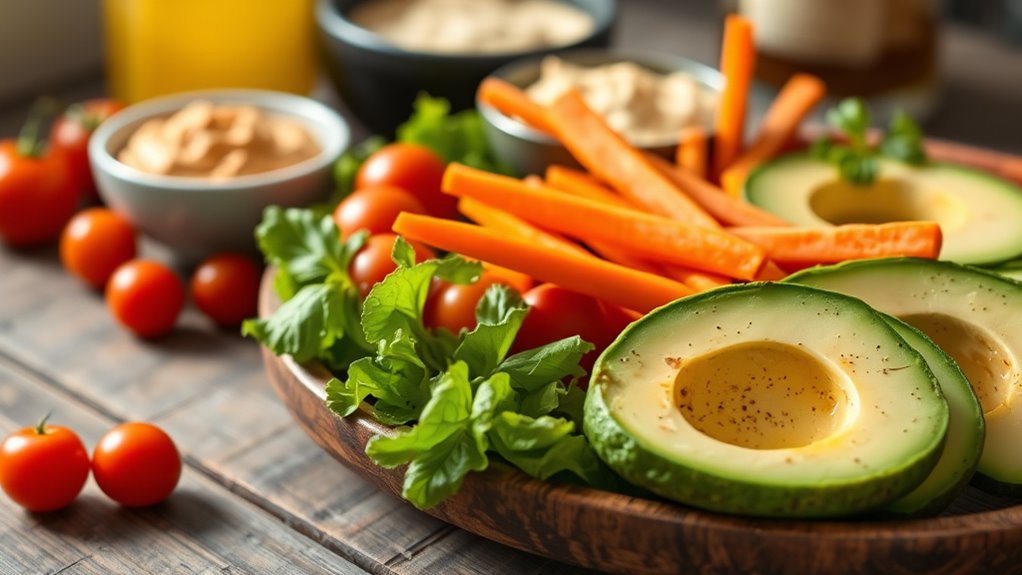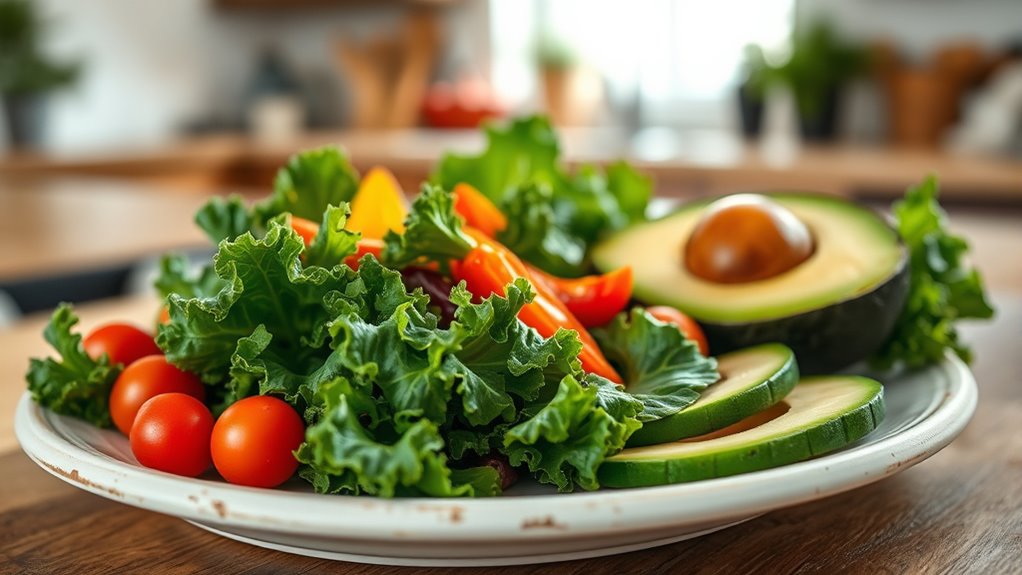Switching to veganism can be easier when you use psychological hacks to manage cravings. Practice mindful eating by pausing before snacking and paying attention to your feelings and body signals. Recognize emotional triggers and replace emotional eating with positive activities like deep breaths or walks. Staying aware of your emotions helps you make intentional choices, while preparing healthy vegan snacks keeps temptation at bay. Keep discovering more strategies to stay on track and enjoy your plant-based journey.
Key Takeaways
- Practice mindful pausing before eating to differentiate physical hunger from emotional cravings.
- Recognize emotional triggers by labeling feelings to reduce impulsive, emotional eating.
- Use alternative coping strategies like deep breathing or walking instead of reaching for comfort foods.
- Enhance emotional awareness through mindfulness to build resistance to cravings over time.
- Prepare nutritious vegan snacks to satisfy emotional needs healthily and prevent unhealthy temptations.

Have you ever struggled to resist cravings while following a vegan diet? It’s a common challenge, especially when those tempting smells or memories hit hard. The key isn’t just about willpower; it’s about understanding your mind and how it reacts to certain situations. One effective approach is practicing mindful eating. Instead of mindlessly reaching for that snack or giving in to an impulse, pause. Take a moment to notice what you’re feeling physically and emotionally. Are you truly hungry, or are you bored, stressed, or seeking comfort? When you focus on your body’s signals, you can make more intentional choices. Mindful eating helps you recognize emotional triggers—those moments when emotions like sadness, frustration, or anxiety drive you toward certain foods. Once you identify these triggers, you can develop healthier coping strategies, like taking deep breaths, going for a walk, or engaging in a quick mindfulness exercise. This awareness reduces impulsive eating and keeps you in control.
Understanding emotional triggers is essential because they often cause cravings that aren’t about hunger. Maybe you associate certain foods with positive memories or feel like you’re missing out on familiar flavors. When these feelings surface, instead of suppressing them, acknowledge what’s going on. Label your emotions and reassure yourself that cravings are temporary. You can also find ways to satisfy those emotional needs without undermining your vegan goals. For example, if you crave comfort foods, try making a plant-based version or indulge in a healthy, satisfying snack instead. Over time, recognizing patterns in your emotional triggers allows you to develop personalized strategies to manage cravings more effectively.
Another helpful tactic is to replace emotional eating with other fulfilling activities. When you notice a craving linked to a specific emotion, distract yourself with something positive—call a friend, read a book, or do a quick workout. These actions redirect your focus away from the craving and help break the emotional link. Additionally, keeping nutritious vegan snacks on hand reduces the temptation to reach for less healthy options when cravings hit. Recognizing that mindfulness and emotional awareness are supported by research on mental health and cognitive function, you can strengthen your ability to resist cravings over time. Remember, cravings are often a combination of physical hunger and emotional needs. By practicing mindful eating and being aware of emotional triggers, you empower yourself to navigate these moments more skillfully. Over time, this approach not only curbs cravings but also strengthens your overall relationship with food, making your transition to veganism smoother and more sustainable.
Frequently Asked Questions
How Long Do Cravings Typically Last After Switching to Veganism?
Craving durations vary, but typically, they last anywhere from a few days to a few weeks after you switch to veganism. Your recovery timeline depends on your eating habits and motivation. During this period, your body adjusts to new foods, and cravings usually decrease as you establish healthier routines. Stay consistent, and you’ll find that over time, your craving intensity diminishes, helping you stick to your vegan goals.
Can Psychological Tricks Completely Eliminate Vegan Cravings?
The jury’s still out on whether psychological tricks can completely eliminate vegan cravings. While mindfulness techniques and habit formation can markedly cut down urges, they might not wipe them out entirely. It’s like chasing rainbows—sometimes you get close, but cravings may still sneak in. Consistently practicing these tricks helps you gain control, but a complete cure isn’t guaranteed. Patience and persistence are your best allies on this journey.
Are There Specific Triggers That Intensify Vegan Food Cravings?
You might notice certain triggers that intensify your vegan food cravings. Emotional triggers, like stress or sadness, can make you yearn for comfort foods. Social situations, such as dining out or parties, often challenge your resolve, increasing temptation. Recognizing these triggers helps you prepare. By developing coping strategies, you can resist these urges and stay committed to your vegan journey, even when faced with emotional or social pressures.
How Do Emotional States Influence Vegan Food Cravings?
Ah, emotions—your secret craving accomplice. When stress hits, emotional triggers fire up, making you crave comfort foods, including vegan treats. Instead of falling for the temptation, you can manage stress better and recognize these emotional cues. By practicing stress management techniques, you weaken cravings’ hold, turning emotional turbulence into an opportunity for healthier choices. Remember, your feelings don’t have to dictate what ends up on your plate.
Is It Normal to Experience Cravings Even After Years of Veganism?
Craving persistence even after years of veganism is quite normal. It’s common to still experience occasional urges, especially if you’ve associated certain foods with comfort or habits. Vegan guilt can also amplify cravings, making you feel like you’re failing. Recognize these feelings without judgment, and remind yourself of your progress. Staying mindful and connected to your reasons for veganism helps reduce craving intensity and boosts your confidence.
Conclusion
So, next time you crave that cheesy pizza, remember—your brain’s just playing tricks. With these hacks, you’ll outsmart those urges and prove that resisting isn’t just about willpower, but clever tricks. Ironically, the more you fight the cravings, the more they seem to fade away—like a mischievous ghost you finally convince to leave. Embrace the challenge, and soon, craving those old favorites will be just a funny memory on your journey to veganism.










